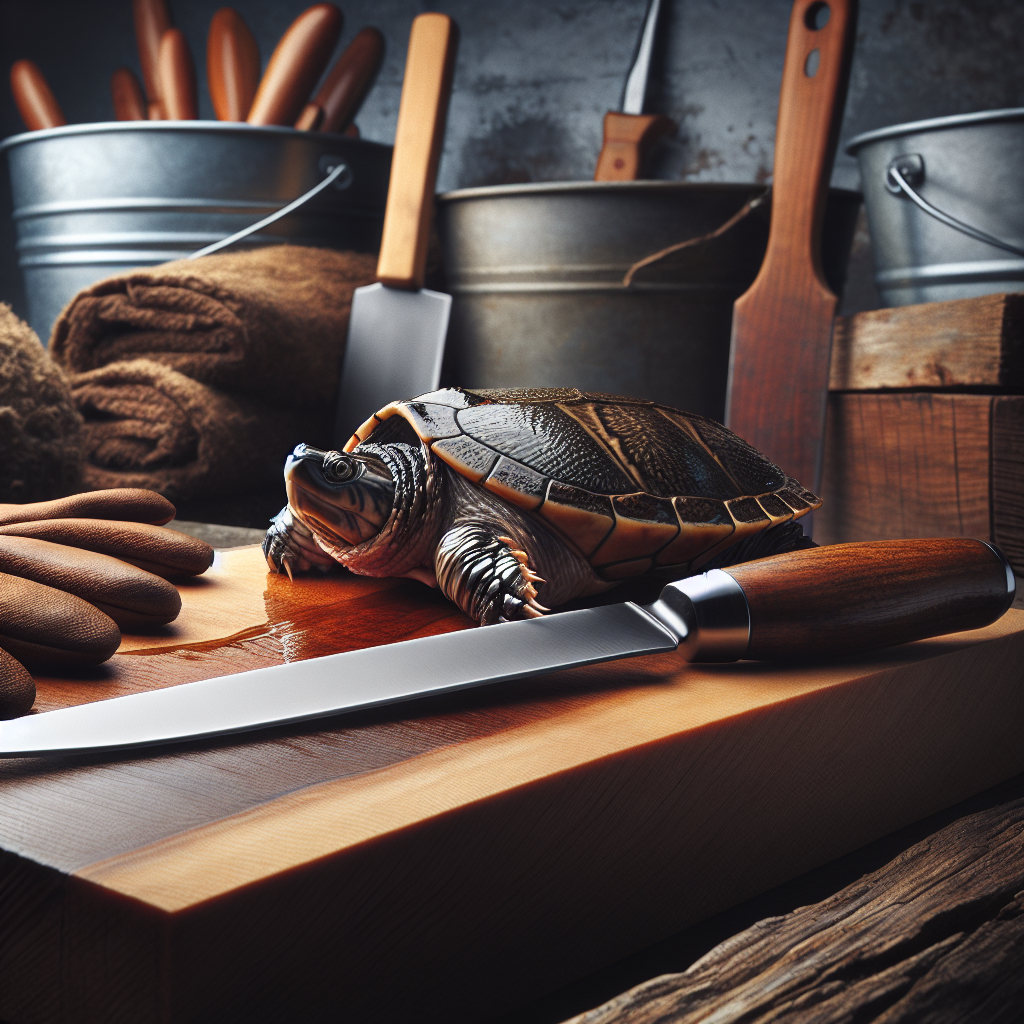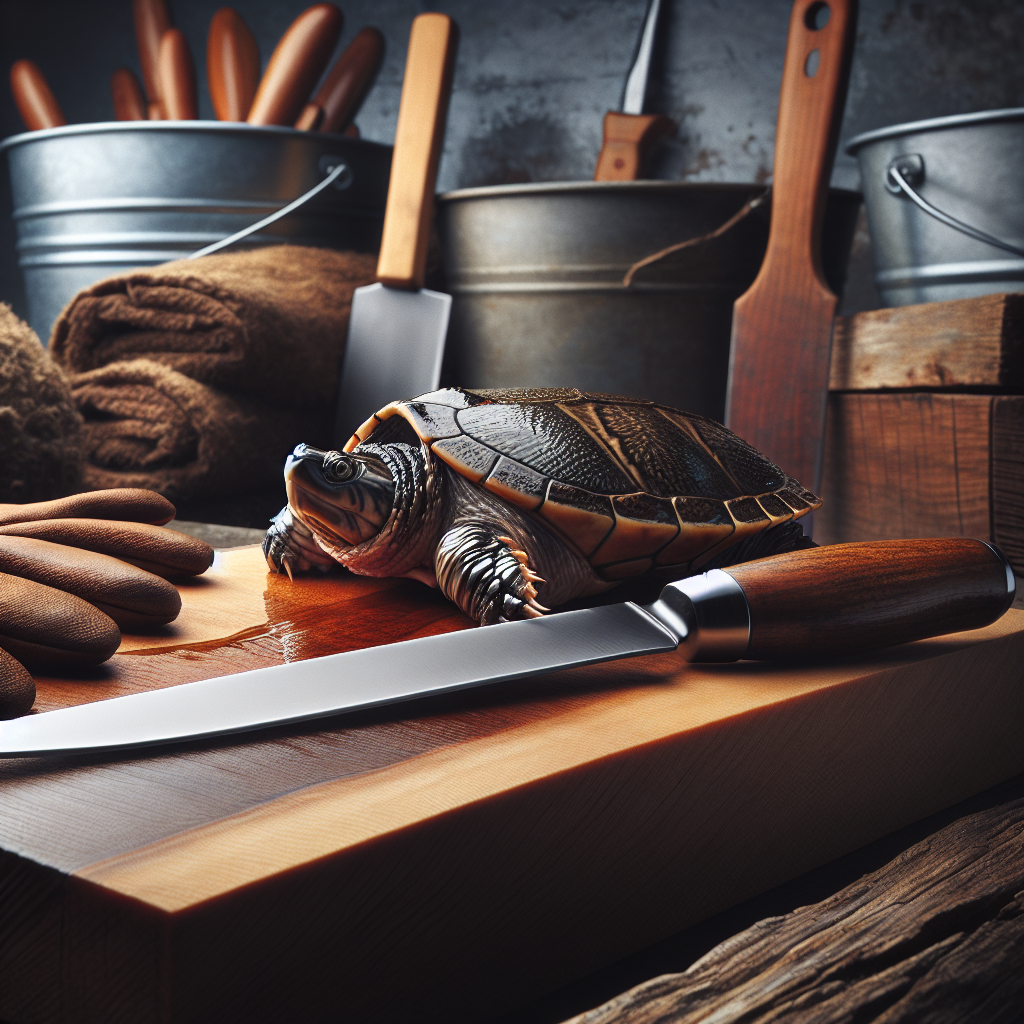Imagine you’re out exploring the wilderness and you stumble upon a snapping turtle – what an incredible sight! But what happens if you decide to take that turtle home and cook it for a delicious meal? Don’t worry, we’ve got you covered. In this article, we will guide you on the art of cleaning a snapping turtle, ensuring you are equipped with all the necessary skills to handle this task with ease. From removing the tough shell to extracting the succulent meat, we’ll take you step-by-step through the process, making sure that your next snapping turtle feast is the most mouthwatering yet. So, grab your knives and get ready to embark on a culinary adventure you won’t soon forget!

Preparing to Clean a Snapping Turtle
Gathering the necessary tools
Before you begin cleaning a snapping turtle, it’s important to gather all the necessary tools. Some essential items include a sharp knife, a pair of heavy-duty poultry shears, a cutting board, a large pot or bucket for capturing the turtle, and a container for disposing of the waste. Additionally, having gloves and protective eyewear is crucial to ensure your safety during the cleaning process.
Ensuring safety measures
When dealing with snapping turtles, it is vital to prioritize safety. Snapping turtles have powerful jaws and sharp claws, so it’s crucial to handle them with care. Always wear sturdy gloves to protect yourself from potential bites or scratches. Additionally, ensure that your workspace is clean and well-lit to avoid accidents while handling sharp tools.
Understanding legal regulations
Before attempting to clean a snapping turtle, it is crucial to be familiar with local regulations regarding hunting, trapping, and cleaning wildlife. Snapping turtles might fall under specific regulations, such as seasons, bag limits, or size restrictions. Check with your local wildlife management agency or consult hunting regulations to ensure you are compliant with the law.
Humanely Killing the Snapping Turtle
Choosing a humane method
When it comes to killing a snapping turtle, ensuring a humane method is crucial to minimize suffering. One of the most widely accepted methods involves stunning the turtle first. You can achieve this by delivering a swift blow to the head using a heavy object like a blunt mallet or a large rock. This should render the turtle unconscious and minimize any potential pain.
Avoiding unnecessary suffering
It’s essential to perform the process swiftly and accurately to avoid causing any unnecessary suffering to the snapping turtle. Aim for a clean, powerful blow to the head to ensure a quick and humane death. Avoid inflicting additional pain or distress during this step, as humane treatment should be the utmost priority.
Removing the Snapping Turtle’s Shell
Finding the correct starting point
To begin removing the snapping turtle’s shell, you must locate the correct starting point. Locate the line where the plastron (bottom part of the shell) meets the carapace (top part of the shell). This line usually runs along the center of the turtle’s belly and back. This is where you’ll begin separating the shell from the body.
Separating the shell from the body
Once you’ve identified the starting point, carefully insert the tip of your knife into the gap between the plastron and the carapace. Slowly work your way around the shell, cutting through the tough connective tissue that holds the two parts together. Exercise caution and patience to avoid damaging the turtle’s meat during this process.
Removing the shell
After separating the shell from the body, gently lift the shell away, exposing the turtle’s meat. Use caution and precision to prevent any unnecessary tearing or damage to the meat. Ensure all remnants of the shell are removed, as they can be sharp and pose a choking hazard when consumed.
Extracting the Snapping Turtle Meat
Detaching the legs
Begin by detaching the legs from the turtle’s body. Place the turtle on its back, and using your heavy-duty poultry shears, cut through the joints where the legs attach to the body. Apply steady pressure and use a firm grip to cleanly separate the legs from the carcass.
Removing the internal organs
To remove the turtle’s internal organs, carefully make an incision along the belly from the breastbone to the tail. Be cautious not to puncture any organs during this process. Use your fingers or a spoon to gently scrape away and remove the organs, taking care not to damage the meat.
Cutting the meat into portions
Once the internal organs have been removed, you can proceed to cut the meat into portions. Use a sharp knife to separate the meat into desired sizes or follow a recipe’s recommended cuts. Ensure that your knife is clean and sharp to make precise cuts, resulting in well-prepared portions of snapping turtle meat.

Cleaning the Snapping Turtle Meat
Rinsing the meat
After portioning the snapping turtle meat, it’s essential to thoroughly rinse it. Place the meat under cold running water to remove any blood, dirt, or debris. Gently rub the meat with your hands while rinsing to ensure a thorough cleaning. Proper rinsing is crucial for the removal of any bacteria or contaminants.
Removing excess fat
Snapping turtle meat can sometimes have excess fat, which may affect the taste and texture of the final dish. To remove excess fat, use a sharp knife to carefully trim off any visible fat deposits. Be cautious not to remove too much meat during this process, as the fat also adds flavor and moisture to certain cooking methods.
Inspecting for any left-over debris
After rinsing and trimming the meat, inspect it thoroughly for any remaining debris or unwanted parts. Search for bone fragments, cartilage, or stray pieces of shell that may have been missed during previous steps. Remove any debris with clean hands and a pair of tweezers to ensure a safe and enjoyable culinary experience.
Cooking and Storing Snapping Turtle Meat
Marinating the meat
Marinating snapping turtle meat enhances its flavor and tenderness. Consider marinating the portions in your chosen seasoning blend or marinade for at least a few hours, or overnight for maximum flavor. Popular marinades include citrus-based blends, soy-based sauces, or herb-infused mixtures.
Choosing a cooking method
When it comes to cooking snapping turtle meat, several methods produce delicious results. Grilling, frying, or slow-cooking are popular options. Grilling imparts a smoky flavor and creates a tantalizing charred exterior, while frying can provide a crispy and golden finish. Slow-cooking methods, such as braising or stewing, allow the meat to become tender and infused with flavorful sauces or broth.
Storing the meat properly
If you have extra snapping turtle meat that you want to store for future use, it is essential to store it properly to maintain its quality and freshness. Place the meat in an airtight container or wrap it tightly in plastic wrap or freezer paper. Label the packaging with the date and store it in the coldest part of your refrigerator or freezer. Make sure to consume frozen meat within a few months for the best taste.
Utilizing Various Snapping Turtle Parts
Preparing the shell for crafts
The snapping turtle’s shell can be repurposed for crafts or decorative purposes. Clean the shell thoroughly to remove any remaining tissue or debris. Utilize the shell as a natural canvas for painting, or use it to create unique jewelry, such as pendants or earrings. Additionally, the shell can be incorporated into artistic sculptures or as a decorative piece in your home or garden.
Saving the turtle’s bones
The bones of a snapping turtle can be saved and used for different purposes. Clean them carefully, removing any remaining flesh or tissue. Boiling or simmering the bones can help remove any residual material. Saved turtle bones can be used in crafting traditional bone tools, jewelry, or even as natural decoration for aquariums or terrariums.
Using the skin for leather
Snapping turtle skin can be transformed into durable and flexible leather material. To begin the process, carefully remove the skin while ensuring it remains intact. Clean the skin thoroughly, removing any fat or visible tissues. Soak the skin in a tanning solution or follow a specific tanning process suitable for reptile skins. Once the skin is tanned and dried, it can be utilized for various leathercraft projects, such as wallets, belts, or even garments.
Disposing of Turtle Remains
Following local disposal guidelines
After cleaning and utilizing the desired parts of the snapping turtle, it’s important to dispose of the remaining remains properly. Check your local regulations or consult with your waste management provider for specific guidelines on disposing of animal remains. They may require special disposal methods or designated locations for wildlife carcasses.
Minimizing environmental impact
When disposing of turtle remains, it’s crucial to minimize any negative impact on the environment. If possible, consider burying the remains in a deep hole away from water sources or areas frequented by other wildlife. This helps ensure that decomposition occurs naturally and does not contaminate water or attract scavengers.
Precautions When Handling Snapping Turtles
Avoiding bites and scratches
When handling snapping turtles, the risk of bites and scratches is significant. Always take precautions by wearing sturdy gloves that provide protection against the turtle’s sharp claws and strong jaws. Avoid placing your hands or fingers near the turtle’s mouth, and maintain a firm grip to prevent sudden movements or escapes.
Properly securing the turtle
To minimize the chances of escaping or causing harm, it’s crucial to secure the turtle properly during handling and cleaning. Use a large pot or bucket with a tight-fitting lid to capture the turtle safely. Ensure that the container is sturdy enough to prevent the turtle from escaping or causing injury to yourself or others.
Alternative Methods for Snapping Turtle Preparation
Finding professional butchers
If you feel uncomfortable or lack the necessary skills to clean a snapping turtle yourself, another option is to find a professional butcher experienced in cleaning game meat. Professional butchers possess the expertise and equipment needed to handle the cleaning process efficiently and safely. Contact local butcher shops or inquire within hunting communities for recommendations.
Joining hunting communities
For those who enjoy hunting and want to learn more about snapping turtle preparation, joining hunting communities can be an excellent resource. These communities often provide workshops, seminars, or hunting events where experienced hunters and butchers share knowledge and techniques. By participating in these communities, you can not only learn valuable skills but also connect with like-minded individuals who share a passion for hunting and wildlife.
In conclusion, cleaning a snapping turtle requires the right tools, knowledge, and safety precautions. By following the outlined steps, you can effectively and safely prepare snapping turtle meat while also utilizing various parts of the turtle for other purposes. Remember to adhere to local regulations, prioritize humane treatment, and respect the environment throughout the cleaning process. Whether you choose to marinate and cook the meat or create crafts from the shells and bones, cleaning a snapping turtle can not only provide unique culinary experiences but also offer opportunities for creativity and resourcefulness.
